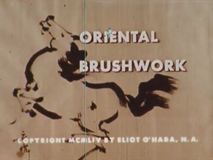
Synopsis from Educational screen & audio-visual guide, December 1956, pp.525-529(Encyclopaedia Britannita Films, 1150 Wilmette Ave., Wilmette, Illinois) 16 minutes, 16mm, sound, color, 1954, $150. Produced by Eliot O'Hara. Film guide available. Description Produced by the watercolorist and art teacher, Eliot O'Hara, and featuring brushwork by Tyrus Wong and Chiura Obata and paintings from the Freer Gallery of Art, Washington D.C., the film explains early and contemporary oriental brushwork — materials, techniques, and effects. Beginning with a shot of O'Hara in the Freer Gallery looking at a nine foot watercolor or scroll called "Plum Branch," the film explains some of the philosophy of Oriental artists. Shifting to "Grapevine in the Wind," the film explains how the artist responded to and as a result painted what he felt. While "River Landscape," a world of Tai Chin in 1850, is being shown the narration explains that ever though it is too late to see such a master ter from the Ming Dynasty at work, it is, nevertheless, possible to observe living Oriental artists who paint in the same tradition. The film shifts to the Los Angeles studio of Tyrus Wong, a Chinese American painter, who paints characters for a number of words. The character for "horse" is shown to be a simplified picture of a horse. Mr. Wong next prepares to paint using rice paper. As he paints a picture of a horse the narration points out his elimination of unnecessary detail and device to convey action. When finished he adds his beautifully painted signature and the seal which lends authenticity to most Oriental work. A landscape, painted by an unknown Chinese artist more than five hundred years ago, is next shown and discussed. How the artist created tension by the use of planes and multiple horizons and how he either moved or completely ignored his vanishing points are discussed. Explaining that the art of watercolor in China was the ancestor of that in Japan, the film shows "Taoist Immortals" and "A Winter Party" as examples of the Japanese art. It next shows Chiura Obata painting a cypress tree. As Obata continues to paint "Thundering Nevada Falls," the narrator explains his techniques and praises the finished painting by saying he gets more real enjoyment out of viewing Obata's painting than the falls themselves. Appraisal Here is a film that condenses many hard-to-obtain experiences into sixteen minutes and makes them readily available to the average classroom. High school and college art classes as well as special interest adult groups including art societies and museum groups will find this film refreshing and highly informative. Covering as it does both Chinese and Japanese brushwork and early as well as contemporary artists, the film accomplishes a great deal without apparent rush or lack of attention to details. The paintings are well chosen in terms of demonstrating the chief media, the various techniques, the history and tradition of Oriental brushwork, and the various effects achieved by the artists. The film should arouse an interest in and an appreciation for Oriental art.
The media player embeds third party contents from YouTube, Vimeo, the Internet Archive and various other sites into this page. If you choose to use this feature, the site serving the content will register your request without you explicitly accessing it. Please check our Privacy policy for more information.
| Id | 3020 |
|---|---|
| Availability | Free |
| Inserted | 2017-01-13 |